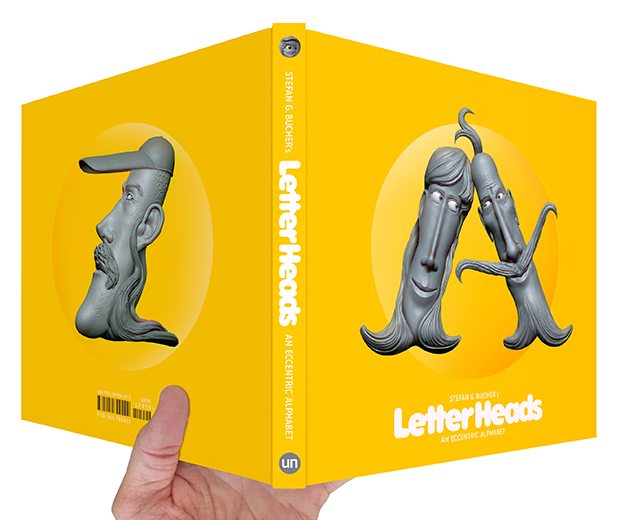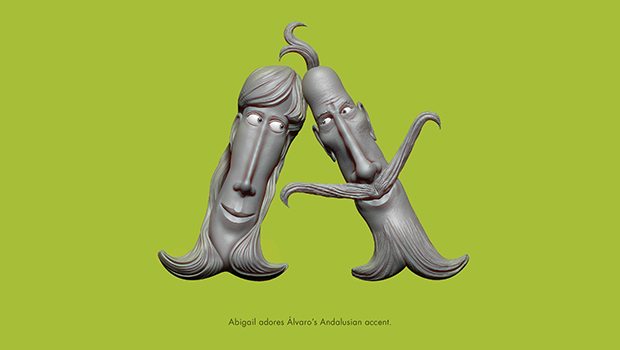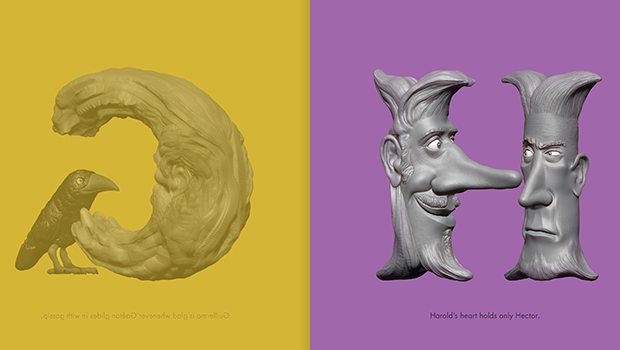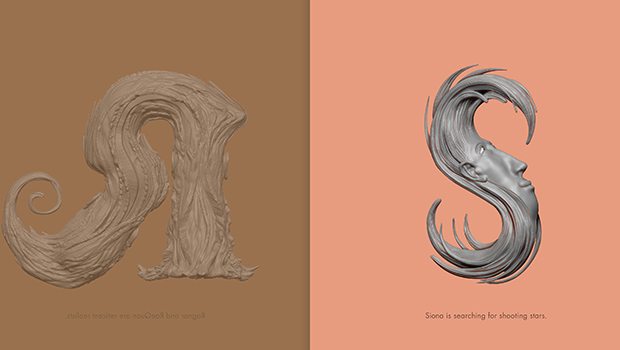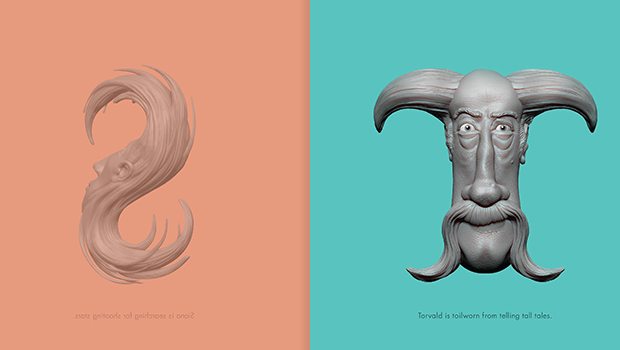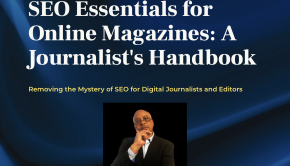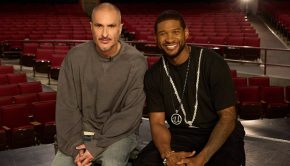Five Questions With Creator and Illustrator Stefan G. Bucher
Stefan G. Bucher the creator of the YouTube Series Daily Monster™, is a prolific graphic designer, illustrator, and writer whose work is seen in so many places and platforms it’s WAY too lengthy to list here but includes things like re-design of Chris Rock‘s Bring The Pain cover for its DVD Release (DreamWorks), The New York Times editorial projects, Film and Television…you get my drift…dude is in demand across the globe for his creative input and visualisations. If you like the design and graphics realms you can see a full list of his work here.
What brought my attention to Stefan and his work, was an email describing his latest creation Letterheads An Eccentric Alphabet and the amazing work that was done to deliver a learning tool that both excited young readers AND celebrated diversity in its characters. As a parent who happens to write, I’ve experienced the challenge of sharing my love of words and letters with my digital age progeny who prefers electronics to paper for which I accept responsibility! Had I had the Letterheads option, I don’t believe Leapfrog and Energizer would have gotten so much of my dough!!!
So what’s the big deal about THIS book?! Check the official line below
Stefan G. Bucher’s LetterHeads is a graphic design book for creatives of literally any age, celebrating diversity and inspired by the people of the artist’s hometown of Los Angeles. Infused with unique personalities, surrounded by playful vocabulary and an intriguing color palette, the letters reflect just how alive language truly is. The use of ground-breaking 3D technology acts as a link to not just the future of letterform creation, but creativity itself.
- Each letter accompanied by a single sentence, and a fascinating color, conveying essential personality traits and emotions.
- Molded and carved like a series of classical sculptures, but free of the gaudy paint jobs!
- A landmark approach to letterform creation, combining decorative lettering of the 19th century with the crisp digital modeling of a Pixar blockbuster.
- Enfolding playful vocabulary with color literacy, celebrating the diversity of both letterforms and people.
- The LetterHeads are collected in a luxurious book design by Bucher himself, featuring a spot gloss varnish cover, 200 gsm paper, and painted page edges.
I got to have a bit of fun with Stefan as I looked to match his creativity with this brief Q&A, and to that end, I put him to work! One of the outstanding pieces from Stefan is a book entitled 344 Questions: The Creative Person’s Do-It-Yourself Guide to Insight, Survival, and Artistic Fulfillment (Voices That Matter). Stefan was asked to “Pick *four* questions from your book *344 Questions* that apply to the creation and any applicable metaphors for *The Letterheads* project. The fifth question is our signature inquiry which he handled with his usual creativity and energy!
How do you choose your teachers?
The search for teachers is one of the big themes in my life. I certainly like figuring things out on my own, but I’ve had some great teachers early on, and it got me addicted. You can see so much more of life with great teachers guiding you. I’m not just talking about teachers in school or college, but about people in my life, and sometimes people I just meet in passing. I try to look at everybody I meet as somebody who can teach me something. I don’t always succeed, but when I stick to the discipline, it certainly helps me recognize people as fellow humans with as much of an inner life as myself.
But as to the actual choosing of teachers, a lot of it is chance. In “Dirk Gently’s Holistic Detective Agency” Douglas Adams talks about Dirk’s investigative technique: He’ll follow any car that looks like it knows where it’s going. He won’t get to where he wants to go, but he’ll always end up where he needs to be. That’s been true of the teachers I found (and who found me) and it’s been true of my career.
What distinguishes a bad idea from a good idea?
To me, I don’t think there are bad ideas, as long as they get me working. Once I start getting over my fear of working to the part where I actually make things, I have enough instinct, experience, and judgment to course-correct my way toward something that’s useful or entertaining. (Also, being entertaining *is* useful!) Having said that, there are ideas that require a lot of evolution and a lot of work to get somewhere useful. Sometimes they take me years of fiddling and cursing until some magical piece falls into place that makes it all fit together. It’s easy to get frustrated, but over time those ideas may lead to something really interesting and new. Sometimes they just lead to the insight never to try that particular thing again. That’s valuable, too. “Good” ideas are just ideas that get you to a powerful solution quickly. But it’s also good not to get stuck in your own competence. That was a large part of what motivated my new book, LetterHeads. I discovered digital 3D sculpting and got to be a beginner again. Yes, I could bring in the character design skills I’d developed from 10 years of the Daily Monster, and a lot of my “respectable” career is designing logos and letterforms, but I had to translate all that through a totally unfamiliar set of tools. And it was a blast! It was so exciting to have to piece together solutions instead of knowing an efficient trick for every situation.
Whose permission do you need to do what you want to do?
Growing up in Germany, I got it in my head that you need certificates and diplomas to do something. You need a license. You need to have proven standing in your area of expertise. I was invested in the idea that you have to HAVE an area of expertise. I think I still do. It may be why I always look for teachers to guide me, and to make me feel that I’m allowed to do what I’m doing because I’m taking it seriously. As I’m getting older, I’ve found some workarounds for this. Whenever I try something new, I bring in a small piece where I know I’ve already proven my skills. In the case of the LetterHeads, I was quite insecure about what “real” 3D artists and sculptors would say. At the same time, I have years of book design experience, and I knew I could produce a beautiful book *around* the characters. That makes the experimentation OK for me. When I wander into a new field others have already dedicated years of their lives to, it’s important to me that I do it with sincerity and with respect for their work— not to copy them, but to acknowledge and honor that I’m on their turf.
Do you think the work should speak for itself?
I think the work should always be able to stand on its own. If you have to explain a piece, it’s not clear enough yet. But all this assumes that people ARE seeing your stuff. I recently saw a great talk by Jack White who said that it’s the artist’s work to share their work with as many people as possible by any means possible, because you never know who’s going to connect with it! I loved that! Ultimately, it’s the connection that matters. So, as much as I hope my work stands on its own, talking about it and explaining a few of the Easter eggs or some of the overall themes can help connect the work to more people. And in the end, that’s what I care about — to connect and to be a positive part of people’s lives in some small way.
What’s been your craziest “WTF” moment thus far in your career?
By following the Dirk Gently method I talked about earlier, I’ve found myself in some strange and excellent situations. I once had an insomniac rock star cold-call me at 6 am. She’d typed in the wrong name for a fashion label and found my website instead, and could I come to her house that night to talk about her new album cover? That led to me hanging out in a Hollywood mansion with her until 4 am, talking about art. So there’s stuff like that. The idea for this new book came from speaking at a conference in Dubai and seeing a software demo by Hollywood creature designer Neville Page. He’s a neighbor here in California and yet I had to fly halfway around the world to meet him. I’m working with people now who have put equipment on Mars. I’ve designed a theater in Las Vegas. I created a character, the Yeti, who took over the holiday windows at Saks Fifth Avenue ON Fifth Avenue. And I get to do it all working from my living room. So… it’s ALL kind of crazy. The WTF moment is what I live for. It’s sometimes frustrating that I can’t give you a ten-second statement of what I do professionally—it’s so all over the place—but every now and again somebody stumbles on my site and says, “This guy thinks like me! We gotta do a [insert crazy-ass thing I’d never have considered possible] together!” Those are the best moments of my life!
Always open to new ideas and projects, Stefan says, “If you have an interesting project you think we should tackle together, please say hello. You can reach me at [email protected].”
This article includes biographical information retrieved from 344design.com.
Tweet


